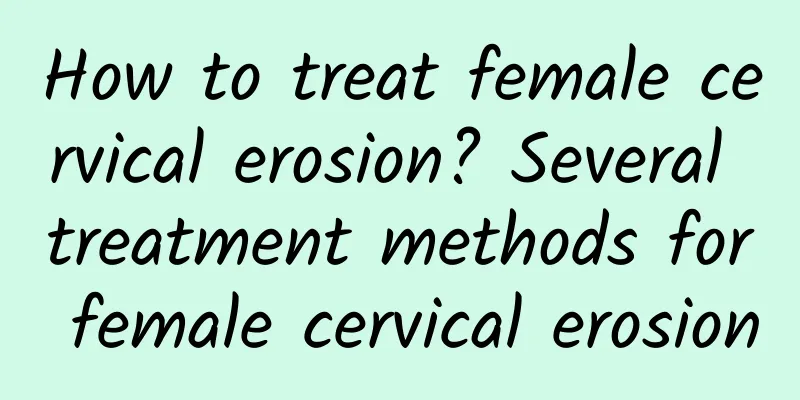What kind of surgery is needed to check uterine fibroids? What are the methods for checking uterine fibroids?

|
What kind of surgery is needed to check for uterine fibroids? Uterine fibroids are one of the most common gynecological diseases in women, and in most cases do not require surgical treatment. However, in some specific cases, surgery is an indispensable method for treating uterine fibroids. So, let's take a look at the surgical methods required to check for uterine fibroids and some of the methods for checking for uterine fibroids. 1. Types of uterine fibroid surgery: a. Hysterectomy: For women who have finished giving birth or no longer plan to have children, hysterectomy is an effective treatment. By surgically removing the uterus, the uterine fibroids in the patient's body can be completely removed to prevent them from causing greater harm to the body. b. Preservation surgery for uterine fibroids: For women who wish to preserve their uterus or fertility, preservation surgery can be chosen. Common preservation surgeries include myomectomy, uterine artery embolization, myomectomy, etc. These surgeries can remove or reduce uterine fibroids as much as possible, preserve the function of the uterus, and provide the opportunity for fertility. 2. Uterine fibroids examination methods: a. Ultrasound examination: Ultrasound examination is one of the most commonly used non-invasive examination methods for diagnosing uterine fibroids. Through ultrasound, doctors can clearly observe the internal conditions of the uterus and understand important parameters such as the size, number, and location of uterine fibroids. b. MRI examination: MRI (magnetic resonance imaging) is a more accurate examination method that can provide more detailed images of uterine fibroids. Compared with ultrasound, MRI can more accurately evaluate the biological characteristics of uterine fibroids and help doctors develop more appropriate treatment plans. c. Transvaginal ultrasound (TVS): Transvaginal ultrasound is a commonly used method of uterine fibroids examination. Compared with conventional abdominal ultrasound, transvaginal ultrasound can provide clearer and more accurate images and is easier to detect smaller lesions. In summary, the surgical methods required for the examination of uterine fibroids mainly include hysterectomy and uterine fibroid preservation surgery. The main means of uterine fibroid examination include ultrasound examination, MRI examination and transvaginal ultrasound examination. The choice of these examination methods and surgical methods depends on many factors such as the patient's age, severity of the disease, fertility needs and personal health status. However, before deciding whether surgery is needed, we should also note that not every patient with uterine fibroids needs surgery. For those with mild or no symptoms, doctors may consider conservative treatment measures such as observation and medication. Therefore, if you find that you have uterine fibroids, it is recommended to seek medical attention in time and consult a doctor's professional opinion in order to develop the most appropriate treatment plan. |
Recommend
Why does my period at the age of 50 come once every two months and why is the amount of blood heavy?
Why does my period at the age of 50 come once eve...
Water-fat type obesity! 10 kinds of food and 4 kinds of tea to drain water
"Doctor, my abdominal fat is difficult to re...
The dangers of having vaginal candidal infection
The harm of candidal vaginitis has attracted more...
What is the difference between uterine fibroids and cervical fibroids? Are uterine fibroids and cervical fibroids related?
Uterine fibroids and cervical fibroids are two co...
Can a pregnant woman with cervical warts give birth naturally?
We can find that in recent years, the number of p...
Relieve stress and lose weight! Supermodel Wang Liya talks about the 6 benefits of exercise
Exercise can make the body healthier, help firm t...
What are the main causes of cervical erosion?
Among gynecological diseases, cervical erosion is...
How to treat mild cervical erosion in women? These drugs are effective for mild cervical erosion
In life, most patients with cervical erosion feel...
What are the symptoms of physiological ovarian cysts?
Ovarian cysts are common gynecological diseases i...
What are the examination methods for vaginitis
Vaginitis is generally easier to cure in its earl...
Conventional methods of Western medicine for treating habitual abortion
Conventional methods of Western medicine for trea...
Is cervical erosion hereditary?
Is cervical erosion hereditary? Many patients hav...
What should women pay attention to in their diet after abortion? Nine dietary precautions after abortion
After a woman has undergone an abortion, the scho...
Causes of irregular menstruation in women Occupational factors affecting women's menstruation
Many women's issues There are two reasons for...
50% of dried radish contains excessive preservatives, beware of gastrointestinal diseases
Next Saturday, the 23rd, is the Dragon Boat Festi...









